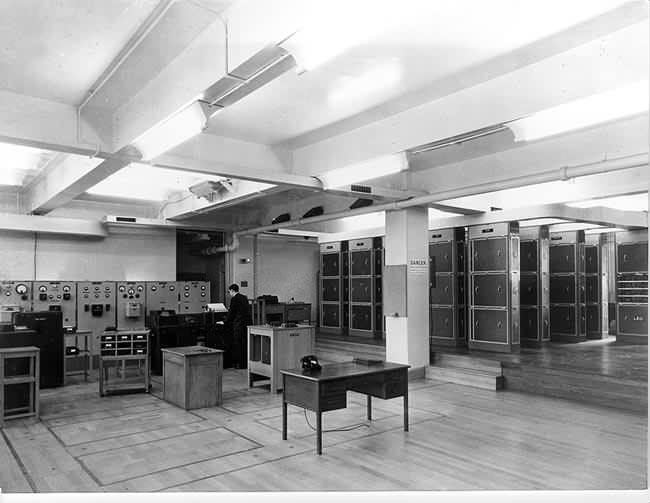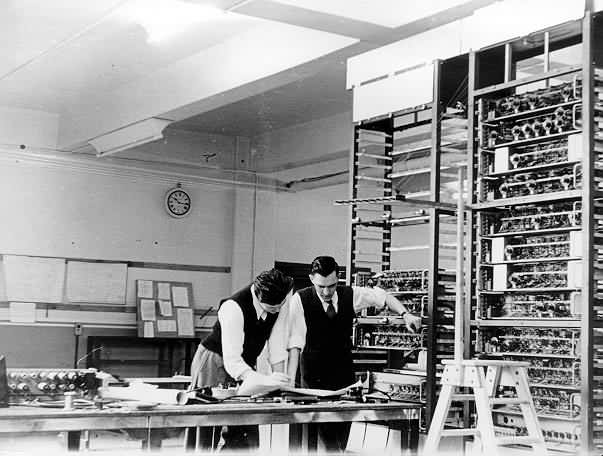

It was George Booth, a man who joined J. Lyons & Co. as company secretary in 1890 who realised the need for an efficient clerical service. His point was that the stock Lyons made had a limited shelf life, and that the money made by customers was only a small profit on each transaction, which could be wiped out should the company produce too much stock which would be wasted. The reason for this was that the prices that customers paid were a little as a few pence (old money) for a bun cake and a cup of tea. Whereas it didn’t cost as much to produce, It was the same in the Lyons retail business, and as a result, the company had an army of clerical staff, who each day would have to process the orders coming in from the numerous teashops and retailers.
During this time, many companies in Britain and America were all starting to realise that a systematic approach to business management meant a more efficient operation. This would in turn result in a guaranteed profit for the company, provided no errors were made. This approach to business management was pioneered by Frederick Winslow Taylor, and became known as Taylorism. Basically the theory was that instead of leaving the manual workers to their own devices in terms of completing a task, that a manager or series of managers should be brought in to analyse the situation and break down specific tasks into a series of repeated steps, thus ensuring efficiency. Soon factories everywhere had men appearing with clipboards and stopwatches, monitoring production in time and motion studies.
Lyons already functioned to an extent with the ideas of Taylorism in place. Each of the different factories within Cadby Hall was set up to handle production of only the specific cake, pie, or loaf of bread in which they specialised. Time and motion studies were implemented by the company, and these would be used to calculate factors such as the cost of the product, and the number of staff needed to ensure efficient working. Booth had followed these studies, and rightfully thought that the same ideas could be extended to the clerical sides of the operations undertaken at Lyons. With these suggestions in mind, Booth went to the board at Lyons to attempt to convince them of this new suggestion.
In J. Lyons & Co until 1923, education had not been a relatively high requirement of employment. Managers for example, were all family members who at one point worked in the kitchens of the Trocadero before almost immediate promotion to Manager in one of the company’s other operations, be that tearoom or hotel. For anyone below managerial level in the company, the normal method of recruitment was to hire people as soon as they left school and train them for specific tasks within the company. Booth insisted that this could not go on without the hiring of some staff with academic qualification, and the company agreed. Five young men were hired as management trainees. One of the first new members of staff hired after this agreement was John Simmons a man who had recently graduated from Cambridge University with a first class degree in Mathematics.
Before entering Cadby Hall, Simmons had little knowledge of business management and it would be fair to say he had not been able to prepare himself for life in the company he now resided with. He was tasked by Booth to investigate the clerical operations which ran at Lyons and make recommendations as to improvements within the system as he saw them. Some of the improvements Simmons brought to Lyons included the introduction of office machines which could be used for bookkeeping and adding. These were brought over from America, however due to the fact that the Americans used the decimal system and a different currency, the clerical staff who used the machines had to be specially trained to convert the numbers they were inputting to the decimal system and back again. A few years later, a book was published promoting good office practice. In this book, the system introduced by Simmons was referred to as what was usually done!
Simmons did not stop with such innovations, and was always looking for a way to improve the efficiency at Lyons. Every operation which took place at Lyons, be it making a cake or pie, or something like the clerical operations was once again monitored in a time and motion study, this time supervised by Simmons.
After his initial success with the bookkeeping, Lyons allowed Simmons to set up a new department within the company – Systems Research. The goal of this new department would be to analyse everything which occurred in the company, and identify any problems or delays which were uncovered, primarily in the clerical side of the operation. Soon after its creation, Simmons and a man called Geoffrey Mills solved a problem in the clerical system relating to the Wholesale Bakery Sales Department. Due to the fact that they had to provide bread and cakes to stores across the country, the amount of paperwork which was coming into the department was immense, much of which were copies of invoices and orders, all repeating the same information. The solution Mills came up with was to use a Recordak, which was an early form of microfilm. The result of this was that one record of customers’ orders was made, and the paper order that was used to make the order could be used for pricing & valuation, then as the packing list, and finally be returned to the customer as an invoice. This meant that there would be nothing to file for the clerical staff, freeing them to attend to other tasks. In what would be a recurring theme for Lyons, they had unknowingly made the first commercial users of microfilm in the world.
Time passed, and the Lyons operation ran successfully under the new implementations which Simmons brought in. Over time, numbers within the Systems Research department grew, and with them, the number of ideas and innovations that such numbers invariably brought. Unfortunately, many of the men who joined this new office were called off to fight for their country during the Second World War. Almost all of the men returned after the fighting ceased, and some of them had brought with them new ideas they had come up with or heard about during their time away. Two such men were Oliver Standingford and Raymond Thompson. Both of these men had requested from Simmons that they be allowed to make a trip to America to see the advancements which had been made in electronic computing during the war. It was their opinion that some kind of electronic calculator would be beneficial to the clerical side of Lyons’ efficiency. Simmons agreed to the trip, as he had intended to send the men to see other innovations in office machinery, as there was no equivalent in the UK. This meant that any discoveries which may be beneficial to Simmons ever continuing quest to improve efficiency would have to come from elsewhere. At this point in time, America had taken Taylorism to heart and as such, a massive industry in office machinery was forming. This had begun with humble beginnings, and involved current innovations such as the punched card calculation machinery being sold by IBM. At this time, IBM was not the massive computer company we now know as a major industry competitor, at this point IBM was trading under the name of International Business Machines.
The company had an increasingly successful business empire across four continents, leasing their punched card machines to companies rather than selling them. They also had the market cornered on the punched cards which were used with their machines. Unfortunately when John Simmons visited America in 1925 to see how big businesses ran their operations, he realised that although tempting, the cost of renting an IBM machine and paying for a constant supply of cards would cost almost s much as what Lyons was already paying their clerical staff. As such, the machines were never brought to Lyons, with Simmons preferring instead to focus on the Taylorism and Leffingwell approaches to business management.
In 1947 however, John Simmons realised that the time was right to investigate advancements which had been made. One of which was the mention of a device called the ‘Electronic Brain’. This was a device which used thermionic valves and was a calculating machine many times faster than anything which was possible to create using mechanical parts, as it instead relied on the moving of electrons.
Simmons sent the men to Princeton, to see a Dr Herman Goldstine who had been the US Army’s liaison to the Moore School of Engineering in Philadelphia. This is where the ENIAC machine had been developed to assist the Army with ballistics trajectories. When working, ENIAC was able to calculate 14 10-digit calculations a second, which was far in advance of what human beings were capable of. This machine cost the American military approximately $800,000. The problem with the machine was that it was unreliable. ENIAC would break down on average at least once per day, and could take a number of hours to be returned to normal operation due to the fact that each of the thermionic valves has a life similar to that of a light bulb. This meant that they constantly needed changing, and the only way of identifying the problematic valve was to replace each in turn and attempt to run the machine again until the fault was removed.
Other shortcomings in the design of ENIAC were soon realised, and a successor to the machine was announced. EDVAC (Electronic Discrete Variable Automatic Computer) would incorporate a number of improvements, chief amongst these were the use of binary to process information fed into the computer, and the ability for the EDVAC to store programs. The architecture used on the EDVAC has since been used on almost every computer in production. This included a control unit, a memory unit, a memory, input and output devices. The EDVAC itself was not a monumental step forwards in computing in itself, but the man who joined the design team John Von Neumann, and the report which he wrote that almost every computer designer referenced.
When the men met with Goldstine, he was incredibly enthusiastic about the idea of using an electronic calculation device in an office environment. He went on to explain the many advantages these machines had over previous efforts such as the punched card machines produced by IBM. In this explanation Goldstine pointed out to the men that there would be little need of human intervention with an electronic computer and that the machine could store its own program, and the results which came from it. After the meeting, Goldstine gave the men a list of names of people who had been performing research into the field, both in the United States, and in England. The men spent their remaining time in America visiting every name on the list, finding out whatever they could about the research currently being undertaken. The men were never able to see ENIAC, as the Army had taken over its use, and back at the Moore school where it was built, the men who had designed the machine had left to form their own company – Electronic Control Company. This new company had been set up by the men with the intention of creating a new computer UNIVAC. This would be the first commercially produced computer of its kind, however the order for the machine was cancelled.
With no hope in sight other than the encouragement from Goldstine, they returned once again to see him, and found that in the time they had been travelling the country, he had been considering their question of a computer in an office environment. He had drawn up a list of parts which the men would need if they were to build their own machine, and took the time to show the men his own partially built computer at his research lab.
Filled with a number of ideas, Standingford and Thompson returned to England having spent their time on the Atlantic crossing writing a report entitled ‘Electronic Machines in the Office’. The report detailed their findings, and suggested a number of ways in which this could in turn be applied to Lyons.
Their return to England saw the men embark on even more research into the field, as they visited Cambridge University to see the final name on the lsit given to them by Goldstine, a man called Douglas Hartree.
Hartree had used the report written by Von Neumann report on EDVAC, he had begun construction of a similar machine along with Maurice Wilkes. Between them, the two men had researched everything there was to know on ENIAC and EDVAC, and following his own trip to America, Wilkes started to design a machine for Cambridge. For this machine, mercury delay lines would improve storage massively compared to the valve storage used on ENIAC. Eventually, in 1947 Wilkes was well on his way to completion of his computer, the Electronic Delay Storage Automatic Calculator – EDSAC.
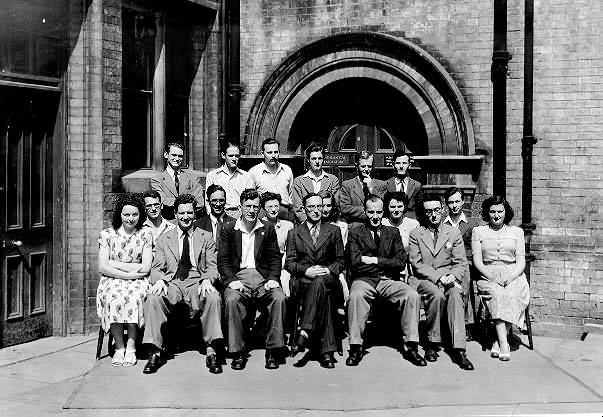
Thompson and Standingford were invited to visit Cambridge to see the EDSAC, despite the fact that it was still over a year from completion. This information was added to the report which was then shown to John Simmons before being presented to the Lyons board in October 1947. The decision from Lyons was at the time to donate between £2000 and £5000 towards the research at Cambridge in order that they complete their machine. Once this machine was complete and Lyons allowed to run their own programs in order to see if it was possible to improve efficiency at the company, the board were prepared to invest £50,000 to £60,000 in building their own machine. It was even decided that in order to ensure that there were few problems, should Lyons decided to build their own computer, they would also construct a second machine as a back up.
When the group from Lyons met with Wilkes in Cambridge, they discussed the idea that Lyons give £3000 and the assistance of an electrical engineer from within the company to assist in the construction of EDSAC, under the condition that should the computer work, Lyons would be able to make their own copy with the assistance of Wilkes. The offer was quickly agreed with, and soon afterwards, Lyons sent their man – Earnest Lenaerts. Work progressed on EDSAC, whilst in Manchester University another computer was well under construction, The MADM (Manchester Automatic Digital Machine). It was the work on this machine which first opened the eyes of the British government to the ideas and possibilities computers could bring. In 1950 EDSAC ran its first successful operation, and started to operate a service for Cambridge University users. Once of the first people to hear of the success of the computer was John Simmons, who saw this as the opportunity to finally have a computer at Lyons. It is reported that he sent the proposal to a board meeting in progress, stating the success of the EDSAC, and requesting permission to commence work on the Lyons computer. The note he received back from the meeting had only one word written on it – ‘Yes’...
Simmons had wasted no time from the point of the initial agreement with Cambridge University and the time the Lyons computer project started. He had spent this time analysing the tasks the computer would be able to undertake, much as he had monitored the workings of the Lyons factory when he started the Systems Research Division. However, to run the project Simmons knew that he needed a manager. He decided upon David Caminer. Caminer was at that point the head of the systems research office, and as such was unable to divert his entire time towards the plans for the computer. He remained a large part of the project, but opted to bring in Derek Hemy, a former trainee for Lyons before the war, who had excelled in radio work and wireless work during the conflict, and had now returned to Lyons to be transferred to systems research. Hemy’s work in systems research was to observe all of the clerical tasks the computer may undertake, and to work out the saving the company would have by using the machine. He later went to Cambridge to work with Wilkes for a number of weeks, learning all he could about programming computers.
Along with David Wheeler, the three men started to look at how programs could be used in the clerical operations that the Lyons computer would need. They started to work on what was the first of a number of test programs for the EDSAC, in order to see if it would meet their requirements. They chose the payroll for the operation; however, when the program was started it became clear that there was a fault. After a period of two minutes, the program stopped with no explanation as to what happened. This was the first in a number of lessons for the men at Lyons, and all subsequent programs written by Lyons after this point were broken down into smaller sections. This allowed the men to find any errors or problems. Something else which became clear to the men was that the amount of storage space needed for the Lyons computer was going to be far in excess of what the EDSAC currently worked with.
Simmons also approached the board at Lyons with the suggestion that once the computer project had been agreed with Cambridge, that it would be prudent to hire an expert of their own so that they would be able to commence work on the Lyons computer as soon as EDSAC proved to be a success. The man who was hired was John Pinkerton, who joined the company in 1949. Soon after joining the company, he and Lenearts moved into rooms above the gatehouse in Cadby Hall and started to experiment with circuits which they gained from second hand machinery. In May of that year after the boardroom agreement, Simmons moved the men into a block of Cadby hall he had long envisioned to be the home of their new computer. In the months that followed, the Lyons computer finally got a name. Simmons himself had been calling the machine the Electronic Office; however, it was soon becoming apparent that the machine had a nickname – LEO, the Lyons Electronic Office.
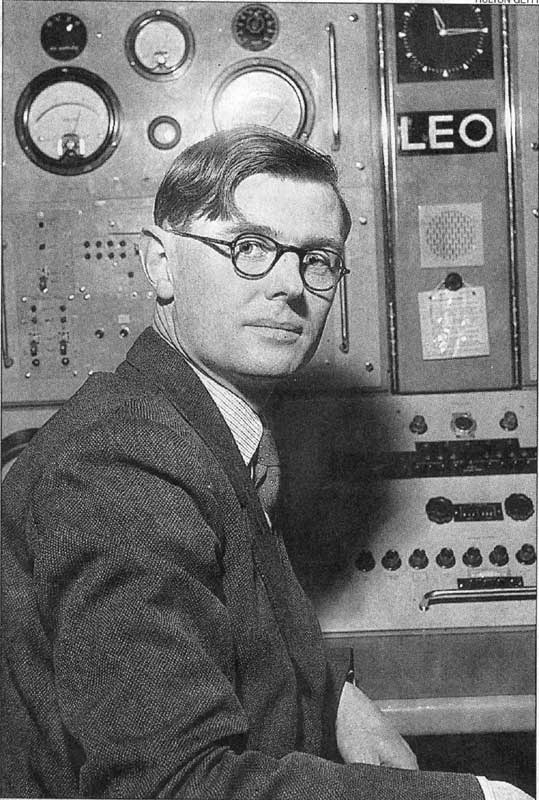
By March the following year, it was suggested that a full time management team inside the LEO project. This was approved, and it soon led to Thompson running the program, with Caminer and Pinkerton in charge of Programming and Technical aspects respectively. Hemy also moved to join the team in the new block. At the same time that the LEO team came together in 1950, Thompson was recruiting a team of programmers for the soon to be built machine. This resulted in Leo Fantl, John Grover, and Anthony Barnes joining the team. During the time the programming team came together, there was no LEO computer for them to program for, instead, the team drew up a number of test programs with which to test the computer for any weaknesses or flaws it may have, so that they could be remedied.
The design for LEO was based primarily on the EDSAC, and for the most part Pinkerton was happy to have this design followed unless there was something which he felt needed to be changed. The first difference in design was something which came from the payroll test program which had been used on EDSAC. It eventually became clear that the reason that this program had stopped on EDSAC was due to the fact that the machine simply did not have enough memory to complete the task. In hindsight it was realised that the reason for this was because EDSAC had been built primarily to perform mathematical calculations. The program the Lyons staff had tested involved storing large amounts of data to be used again and again. It also held words as well as numbers, which meant that the amount of memory needed to have the program run successfully was woefully inadequate. When it came to designing LEO, Pinkerton decided to double the amount of mercury delay lines from 32 to 64. His hope was that by doubling the memory, he would have created enough to comfortably run the programs that LEO would have to. This was the first of many parts of LEO to be built by someone outside of Lyons. This was due to the fact that each delay line had to be perfectly identical, which was something that couldn’t be guaranteed if they were produced by the LEO team. They were created by the Coventry Gauge and Tool Company.
Another change made to the EDSAC design was in the valves which would be used. With EDSAC, 3000 valves were used, and when one of the failed, it would take a vast amount of time in identifying the problem component, as each would have to be replaced one by one, with the machine tested after each replacement until the fault was found. Pinkerton realised that in Lyons, the time that this would take meant that a change had to be implemented. It was decided that units of valves would be built instead. These units would house 28 valves each, and would be stored in large racks, each of which would hold twelve units. The idea behind this was that rather than having to change each valve individually, groups of valves could be replaced and tested in a much shorter space of time. Construction of the units was also handled by an outside company, the boat building firm Camper and Nicholson.
After two years of construction, decisions were being made on how to deal with the input and output from the machine. EDSAC in Cambridge had one input and one output. This was fine for mathematical calculations, however to deal with the large amounts of clerical work which the LEO was going to be undertaking, it was decided that three inputs and two outputs were required as a bare minimum. Lyons went into partnership with Standard Telephones and Cables (STC) who at the time were experimenting with the use of magnetic tape. They started development of tape drives for Lyons which would not only load data into the LEO at high speeds, but also convert it to binary. They also promised output devices which would link to either printers or card punches. Delivery for the components was promised for May 1951. This was the date that LEO was supposed to go into operation. Unfortunately as Pinkerton discovered to his dismay, towards the end of 1950 STC were nowhere near ready with the tape drives they had promised Lyons. It seemed that the company had instead been using the Lyons funding to experiment in these fields with the hope of being able to produce working drives for LEO.
In order for Pinkerton to show off LEO working, he decided that for the short term the computer would use paper tape or punched card readers. This meant that to compensate for the slow input and outputs, delay lines would have to be included in the design to act as a buffer. It was decided that for the short term, simple clerical tasks would be performed on the LEO, until the arrival of the magnetic tape units, at which point more complex operations such as payroll would be added to the work performed on the machine.
The decision was made by David Caminer to pick the job known as bakery valuations to test the machine. This involved calculating the value of the week’s products – bread, cakes etc, taking into account the indirect costs of producing these items such as power to run the ovens and labour costs. It had to calculate the value of products leaving the factories for distribution to grocer’s shops, private customers, and of course the company’s own teashops and restaurants. The retail price for these items and the profit margins would be calculated, and the amounts of each item held in stock. Before LEO, this process was performed as three separate tasks. The idea of using this particular job to run on LEO was that whilst simple, it would save the clerical staff an average of 50 hours per week.
In order to create the program to use on LEO, Caminer drew up a flow chart of the different of the job, and how they related. In effect, this was one of the first uses of systems analysis within computing. Joh Grover was the man tasked to writing the program for Caminer, and on the 5th September 1951, LEO ran the bakery valuations job successfully for the first time. This was not however the time the computer would take the job on full time. Instead, LEO took over operations of the bakery valuations job on 29th November 1951. In doing so, LEO became the first computer to run a full routine office job.
News of the LEO computer’s success was kept from the outside world for a number of years. Explanations for this are many, but the belief is that Simmons did not want competitors to be able to plagiarise the hard work of the pioneers. However, word inevitably leaked, and a week before the Bakery Valuations job went into full time service, a note was sent from the Ordnance Ministry, asking for time on LEO in order to compute missile trajectories in exchange for £300. This was done of a night, when the operations run for Lyons ended for the day. Within a year of its launch, LEO was working on tasks for a number of other people, including weather forecasting for the Met Office. Eventually, it was seen that LEO could provide another income for Lyons by allowing other to run programs on it when not in use by the company. Soon it became the case that when not being used by Lyons, all of the spare time the computer had was occupied by other companies programs.
Within the first year of its use, the LEO team was joined by a number of new programmers, each having passed a training program set by Hemy. By January 1952, the LEO was operating with a success rate that even the designers couldn’t have dreamed of. In those days, it was considered good if a computer had an operational efficiency of over 50%. In a test carried out in the January, LEO was found to have an operation efficiency of approximately 87%. Unfortunately, later that year it became clear that the Magnetic Tape devices promised by STC to allow high speed input into the machine were never going to materialise. Instead, the LEO team began work on ‘The Consolidation Project’. This was a plan to introduce three inputs for LEO, one for paper tape, and two for punched cards. These were all going to be the fastest devices available on the market, and would be installed on the computer with delay lines in place as buffers. This would allow for the difference in speeds of the devices ensuring that LEO was fed information correctly. It also meant that on the output side, LEO was able to move on to the next part of whatever program it was running without having to wait for the output of the previous section to be printed.
On Christmas Eve 1953 LEO was pronounced complete.
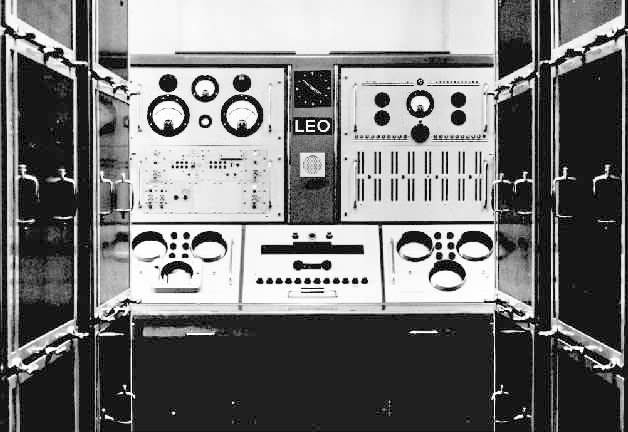
February 12th 1954 saw LEO take on the first task that had been envisioned by its creators from the beginning – payroll. It was predicted that the operation of producing an employee’s wage slip should take no more than three seconds. When LEO went into operation, it actually performed this task in what has been recorded as 1.5 seconds.
With a fully functioning computer, Lyons decided the time was right to show LEO to the world. A press conference was held at Cadby Hall, where the computer was shown to the public for the first time to critical acclaim. Almost every newspaper covering the event was marvelled by LEO, and the possibilities it held. During this time, new programs were created by the LEO team to take over more of the tasks which were performed within the company, this time, the stock ordering for the teashops. Over the next few weeks and months, a program was written. By putting the weeks orders through on punched cards updated every week by staff assigned only to that role, LEO soon took over this task from the clerical staff and assisted the management in the teashops.
To all who saw it, LEO was an unprecedented success, and continued to be so for Lyons for another fourteen years, working on the programs written for it from the very beginning, without ever so much as a real problem.
On 4th January 1965, another press conference was held. As with the first, the creators of LEO were present, as well as other guests and Lyons board members. This however, was a more solemn event than the one which heralded LEO all those years before. At 6pm, LEO was turned off for the final time. Afterwards, some of the parts were sent to the Science Museum, others such as the mercury in the delay lines were sold off for scrap. The LEO had become obsolete years before, but had continued to work well for the company. This event was considered a sad moment by all involved, a moment in computing history as the world’s first business computer was dismantled.
